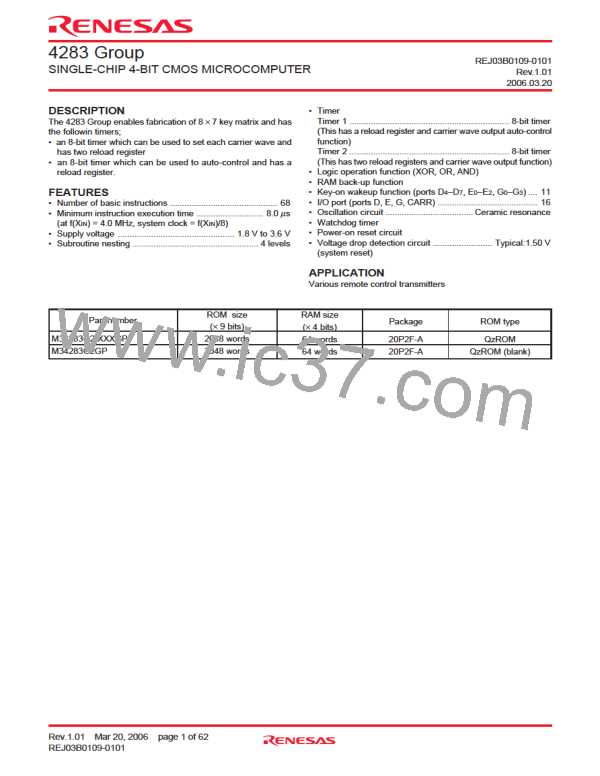4283 Group
LIST OF PRECAUTIONS
✕ Noise and latch-up prevention
Connect a capacitor on the following condition to prevent noise
and latch-up;
✕ Timer
•
Count source
Stop timer 1 or timer 2 counting to change its count source.
Reading the count value
•
•
connect a bypass capacitor (approx. 0.01 µF) between pins
VDD and VSS at the shortest distance,
equalize its wiring in width and length, and
use the thickest wire.
Port E2 is also uesd as VPP pin. Connect this pin to VSS
through the resistor about 5kΩ which is assigned to E2/VPP
pin as close as possible at the shortest distance.
Stop timer 1 or 2 counting and then execute the data read
instruction (TAB1, TAB2) to read its data.
Watchdog timer
Be sure that the timing to execute the WRST instruction in
order to operate WDT efficiently.
•
•
•
•
•
•
Writing to reload register R1
When writing data to reload register R1 while timer 1 is
operating, avoid a timing when timer 1 underflows.
Timer 1 count operation
✕ Register initial values 1
The initial value of the following registers are undefined after
system is released from reset. After system is released from
reset, set initial values.
• Register D (3 bits)
• Register E (8 bits)
When the bit 5 of the watchdog timer (WDT) is selected as
the timer 1 count source, the error of maximum ± 256 µs
(at the minimum instruction execution time : 8 µs) is
generated from timer 1 start until timer 1 underflow. When
programming, be careful about this error.
Stop of timer 2
•
•
✕ Register initial values 2
The initial value of the following registers are undefined at RAM
Avoid a timing when timer 2 underflows to stop timer 2.
Writing to reload register R2H
backup. After system is returned from RAM back-up, set initial
values.
• Register X (4 bits)
• Register Y (4 bits)
• Register D (3 bits)
• Register E (8 bits)
When writing data to reload register R2H while timer 2 is
operating, avoid a timing when timer underflows.
Timer 2 carrier wave output function
When to expand “H” interval of carrier wave is valid, set “1”
or more to reload register R2H.
•
•
Timer 1 and timer 2 carrier wave output function
Count starts from the rising edge in Fig. 29 after the first
✕
✕ Stack registers (SKS)
falling edge of the count source, after timer 1 and timer 2
Stack registers (SKs) are four identical registers, so that
subroutines can be nested up to 4 levels. However, one of
stack registers is used respectively when using an interrupt
service routine and when executing a table reference
instruction. Accordingly, be careful not to over the stack when
performing these operations together.
operations start in Fig. 29.
✕
Time to first underflow in Fig. 29 is different from time
✕
among next underflow in Fig. 29 by the timing to start the
✕
timer and count source operations after count starts.
✕
✕ Notes on unused pins
Count source
Connection
Pin
Usage condition
Timer value
3
2
1
0
3
2
1
0
3
Open.
D
D
0
–D
3
7
Connect to VDD.
Timer underflow signal
Open (Set the output latch to “1” ).
Open (Set the output latch to “0” ).
Connect to VDD.
4
–D
Pull-down transistor OFF.
✕
✕
Pull-down transistor OFF.
Pull-down transistor OFF.
✕
Timer start
Open (Set the output latch to “1” ).
Open (Set the output latch to “0” ).
Connect to VDD.
E
E
0
2
, E
1
Fig. 29 Count start time and count time when operation
starts (T1, T2)
Pull-down transistor OFF.
Open.
✕ Program counter
Connect to VSS.
Make sure that the program counter does not specify after the
last page of the built-in ROM.
Open (Set the output latch to “1” ).
Open (Set the output latch to “0” ).
Connect to VDD.
G
0
–G
3
Pull-down transistor OFF.
Pull-down transistor OFF.
Open.
CARR
(Note when connecting to VSS and VDD)
•
Connect the unused pins to VSS and VDD at the shortest
distance and use the thick wire against noise.
Rev.1.01 Mar 20, 2006 page 23 of 62
REJ03B0109-0101

 RENESAS [ RENESAS TECHNOLOGY CORP ]
RENESAS [ RENESAS TECHNOLOGY CORP ]